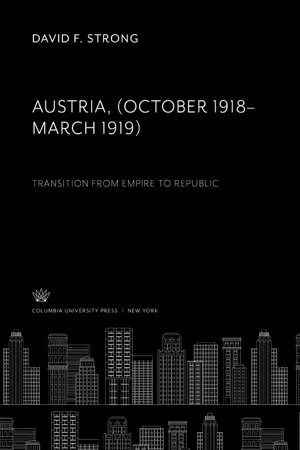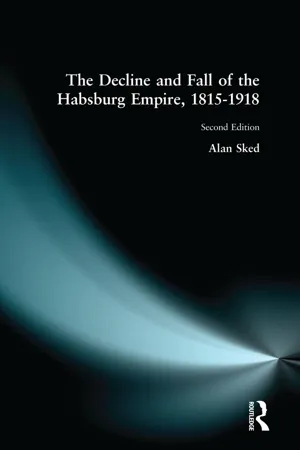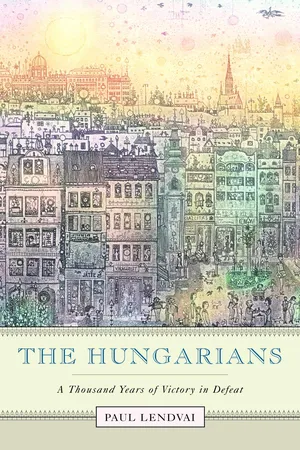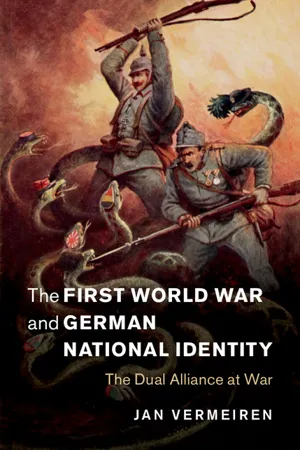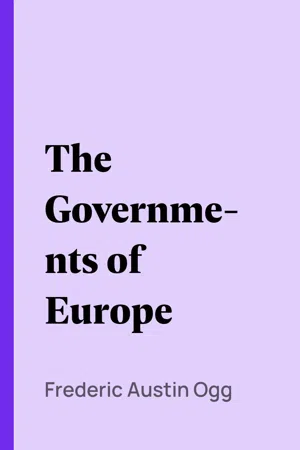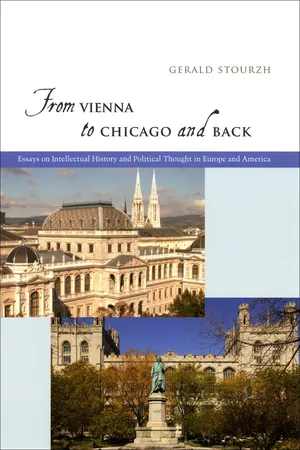History
Ausgleich
"Ausgleich" refers to the 1867 compromise between Austria and Hungary, which established the dual monarchy of Austria-Hungary. This agreement granted Hungary significant autonomy within the empire, including its own parliament and control over domestic affairs. The Ausgleich aimed to address the growing demands for autonomy and recognition of national identities within the empire.
Written by Perlego with AI-assistance
Related key terms
1 of 5
9 Key excerpts on "Ausgleich"
- David F. Strong(Author)
- 2019(Publication Date)
- Columbia University Press(Publisher)
i6 IN THE WAR absent in 1914. 1 This does not imply that all was running smoothly in the Habsburg territories. Far from it. But whatever of nationalistic sentiment existed among the minorities was directed toward the attainment of equality with the dominant groups in the two halves of the Monarchy, the Germans of Austria, and the Magyars of Hungary, rather than toward an independent existence. 2 But quite aside from the effect of the war years on the minori-ties, this same period accentuated the latent hostility of the two dominant peoples, especially because Hungary, the granary of the Habsburg monarchies, had, in the eyes of the Austrians, withheld a fair share of its food supply. In the story which fol-lows, we must keep in mind this underlying source of irritation. For the Central Powers, the War was a process of strangulation under blockade, and it was the privations involved in this which ultimately forced them to surrender. The link which held together the Austrian Empire and the Kingdom of Hungary was the Ausgleich of 1867. The difficulty of combining these two parts of the Habsburg dominions was registered in the ingenious devices by which each sought to hold its own against the other. In the years before the War, there was an almost chronic disagreement in policy between the two gov-ernments, and the Ausgleich which was made for ten years at a time was last renewed in 1907. It was therefore due for renewal again in 1917. THE Ausgleich OF 1867 The provisions of the Ausgleich were the result of a bargain whereby the Emperor and the Vienna Court, with certain pre-conceived ideas of government, conceded in 1867 only what was necessary to gain the support of the Magyars, while the latter demanded their former constitution and a free hand in main-taining their feudal position in the territories of the Crown of St. Stephen. Dividing the Empire into two autonomous parts, 1 Redlich, J. Austrian War Government, pp. 68-69, 75-76. 2 Ibid., pp.- Alan Sked(Author)
- 2015(Publication Date)
- Routledge(Publisher)
Let us begin by looking at the Compromise. Some historians prefer to use the word ‘settlement’, but if it was a settlement it was hardly a popular one. The Germans of the Monarchy soon came to detest it and many Hungarians also wanted to alter it. The other races of the Monarchy – quite properly – felt cheated by it. Yet it stuck in its essentials.The Magyar leadership refused to countenance any alternative that would leave them with less power. And since Franz Joseph was not prepared to concede them any more, the Compromise was to become the sheet-anchor of the Hungarian state. Nothing could be done which might undermine it. Its terms came to be set in concrete, and only the end of the Monarchy was to bring the end of the Ausgleich.Most historians, like most contemporaries, have scarcely had a good word to say for the Compromise. Nor is it difficult to understand why. In the first place, it was an agreement made, not between the representatives of the various parts of the Monarchy, but between Franz Joseph and the Magyar leadership. Having reached this agreement, he then forced it on the ‘Austrian half’ of his domains, despite its unpopularity with most of his subjects there. Indeed, one leading Hungarian historian has recently suggested that it was not even popular with his Hungarian subjects. According to György Szabad, the Hungarian parliamentarians who drew it up had failed to address themselves ‘to the questionable legality of the 1865 elections and [had] failed also to take into account the fact that the conditions of the proposed settlement were hardly known to the electors who had given [Deák’s] party its parliamentary majority. For not a word had been said in the course of the 1865 elections abut revising the 1848 laws to extend the sovereign’s prerogatives, and even the section of the programme discussing joint affairs had not yet been published in Hungary.’1 This, however, is a curious view, first since nearly all elections in Hungary in the nineteenth century were of ‘questionable legality’ and, secondly, because it is extremely doubtful whether Deák can in any way be accused of misleading the Hungarian electorate. In the words of László Peter: ‘When parliament was convoked in the autumn, neither the electorate nor the elected could be in much doubt about the kind of constitutional settlement Deák had intended to secure. His principles were above board. It was all the more noteworthy, therefore, that in 1865–66 not a single Hungarian politician raised his voice against Deák’s course…. The unity with which parliament expressed its wish to settle up with the crown in early 1866 was impressive. Kiegyenlités [settlement] did not yet have the pejorative connotation which, through its artless translation to “compromise”, it has come to have since…. Deák’s authority was immense; most deputies recognised his leadership, and parties as such did not yet exist.’2- eBook - PDF
The Global Political Economy and Post-1989 Change
The Place of the Central European Transition
- E. Ashworth(Author)
- 2000(Publication Date)
- Palgrave Macmillan(Publisher)
This political independence was enshrined in the Ausgleich compromise of 1867, which established a dual monarchy in which Austria and Hungary owed allegiance to the Habsburgs, but had completely independent legislatures, constitutions E. De Boer-Ashworth, The Global Political Economy and Post-1989 Change © Elizabeth De Boer-Ashworth 2000 Hungary 129 and political administrations. There were joint agreements on trade, taxation and transport which were covered by renewable 10-year agree- ments. Any expenditures that fell under joint jurisdiction was paid for through customs duties and separate national contributions. The Austro-Hungarian Empire was held together through the institutions of the Habsburg monarchy and the imperial army. However, the day- to-day running of Austria and Hungary was completely separate and the governance of each part of the empire thus significantly different. Male suffrage, for instance, was introduced in Austria before the First World War, whereas Hungary continued to maintain a more archaic political structure until the break up of the Habsburg empire in 1918. The break-up of the Austro-Hungarian Empire was a direct result of their being on the losing side of the First World War. Vienna was forced to agree to the same armistice terms as Germany. Under these terms the defeated Central European powers were forced to give up considerable territory. Similarly, the Wilsonian principles of self-determination would encour- age ethnic minorities within the former Austro-Hungarian empire to lobby for independence at the Versailles Conference. As a result Hungary lost two-thirds of its territory leaving many ethnic Hungarians (Magyars) living under the jurisdiction of other states. The problem of large ethnic groups outside its borders plagues Hungary to the present day. After 1918, the Hungarian government declared Hungary a republic in protest over its treatment under the armistice. - eBook - PDF
- M. Fitzpatrick(Author)
- 2012(Publication Date)
- Palgrave Macmillan(Publisher)
On June 1, 1867, the Upper House ratified the treaty of the Compromise (Ausgleich) and with that the Austro-Hungarian (Dual) Monarchy was on its way to becoming a reality. 56 Even though a political settlement had been reached there was one more important if symbolic step to be taken, with the law requiring the signature of the king of Hungary, however Emperor Francis Joseph had not as yet been officially crowned in this capacity. The left, unable to stop this from hap- pening, attempted to postpone the ritual as long as possible. On June 4, the Lower House debated the issue and József Madarász recalled the law of 1848, asking for the complete independence of Hungary from Austria. In spite of the 13 leftist members’ objections, the house voted in favor of the corona- tion allowing Franz Joseph the sum of 50,000 as a “coronation honorarium.” Amidst pomp and ceremony, four days later Emperor Francis Joseph was crowned as the apostolic king of Hungary. The ratification of the Compro- mise on July 28 by the Diet, and by the Austrian Reichsrat on November 21 was thereafter assured. 57 Following the Compromise, relations between the left and the ruling Deák-party became somewhat more amicable with the king’s general amnesty for the participants of 1848–1849. It is with this coexistence of the anti- Austrian Left with renewed Habsburg supremacy in mind that András Ger˝ o has argued that the post-Compromise era harbored “ dual aspect of liberal- ism,” that is, remnants of the reform era and a re-feudalisation of private property and taxation. 58 This renewed goodwill extended so far as a bill 106 ● László Kürti that offered general health and retirement benefits to widows and orphans of soldiers who fell during the war of independence. - eBook - PDF
The Hungarians
A Thousand Years of Victory in Defeat
- Paul Lendvai, Ann Major(Authors)
- 2021(Publication Date)
- Princeton University Press(Publisher)
The jacket was a jacket, but the trousers were the relic of an extinct black-and-yellow outfit that had been ripped apart in the year 1867. 5 These quotations (and some of Musil's other reflections) about Kakania and its polit ical and national conflicts give us an idea, which is still viv id to this day, why so many Austrian s heartily loathed the Compromise, both in form and in substance. Even such a balanced chronicler of the Habsburg Empire's history as Robert 284 The Hungarians A. Kann stressed that Austria became the political prisoner of the Hungarians' interpretation of the Compromise. 6 Understandably the Slavs living in the Monarchy, who made up 47 per cent of the total population, and the Romanians (with 6.4 per cent) rejected out-of-hand the distribution of power among the Germans (24 per cent) and the Magyars (20 per cent), which turned them into sec-ond-class nations. Far more complicated, and much-debated, is the question why public opinion, notable historians and many politi-cians in the land of putative victories , i. e. the Hungarian half of the Monarchy, complained so vigorously about the subordinate position, political and economic dependence and even the alleged colonial position of the Hungarians. In order to understand future developments, above all the evi-dent and politically explosive discrepancy in Hungary between fact and perce ption, between objective conditions and subjective impressions, we have to examine closely the essential mechanism c?f the Compromise. It was more than a personal union, i. e. a coalition of two states with a single ruler; it was a real union (a Realunion), strictly a treaty between two separate and, in important ways, sover-eign states-but by no means in all. The French historian Victor-Lucien Tapie described the agreement as one of the most peculiar constitu tional documents of the nineteenth century, as far as con-tent and form are concerned. - eBook - ePub
The Hungarians
A Thousand Years of Victory in Defeat
- Paul Lendvai, Jefferson Decker(Authors)
- 2014(Publication Date)
- Princeton University Press(Publisher)
25. Victory in Defeat: The Compromise and the Consequences of DualismOn 19 December 1867, some months after the coronation and the adoption of the historic agreement which became known as the Compromise between Vienna and Budapest, Ferenc Deák, the “Sage of the Nation” and most influential Hungarian politician, gave a speech outlining the basic principles. The spokesman of the Liberals drew up an extremely positive balance-sheet before a delegation of citizens in the capital:It can be said that never since the defeat at Mohács have the lands of the crown of St Stephen been so united. It can be said that never since the Austrian dynasty began to rule has the relationship between ruler and nation been so trusting. It can be said that never has there been so little disagreement and bitterness between us and Austria as now. It can be said that foreign capital, which has so far not even risked getting to our borders, is flowing now to a greater extent and more freely into the country, and our people are capable and clever enough to take advantage of this for our fatherland. If we want to upset all this, then we are attacking the basis of the compromise, and the entire edifice will most likely be toppled.1Without mentioning Kossuth, viewing these events rancorously from his exile, the architect of the pioneering agreement hinted in this speech at the criticism of the national opposition, in whose eyes the country had not attained true independence:Most European powers are so great and have at their disposal so much power that Hungary could not exist in their midst as a single, independent entity without an alliance offering secure support. Fate has placed our country in the midst of Great Powers, each of which could undoubtedly sweep us away with its superior armed force if it believed that we stood in the way of its wishes and plans. - eBook - PDF
The First World War and German National Identity
The Dual Alliance at War
- Jan Vermeiren(Author)
- 2016(Publication Date)
- Cambridge University Press(Publisher)
At a mass German-Austrian gathering in Berlin in May 1922, the Social Democrat Paul Löbe, President of the Reichstag and chairman of the Volksbund, explicated the new strategy of Angleichung: The Treaty of Versailles explicitly allows the unification of Austria and Germany on the condition of the League of Nations’ permission. We want to prepare this day by cherishing our cultural and national community, by abolishing pass- port and visa chicanes, by harmonizing railroading and railway schedules, by adjusting our school and educational system, and by adapting our economy and our trade to each other. We want to be domestically prepared so that on the day, when the boundary posts fall, the united Reich is already existent. 26 In Germany, the unsettled state of the Anschluss problem and, arguably even more importantly, the loss of Reich German areas widened the gap between the territorial-political entity and the ethno-cultural national community. There was a high interest in the fate and suffering of the 24 For the broader context, see G. Romsics, Myth and Remembrance: The Dissolution of the Habsburg Empire in the Memoir Literature of the Austro-Hungarian Political Elite, trans. by T.J. DeKornfeld and H.D. Hiltabidle (Boulder, CO, 2006) and The Memory of the Habsburg Empire in German, Austrian and Hungarian Right-Wing Historiography and Political Thinking, 1918–1941, trans. by T. Cooper (Boulder, CO, 2010); K. Müller and H. Wagener (eds.), Österreich 1918 und die Folgen. Geschichte, Literatur, Theater und Film (Vienna, 2009); A. Koz ˙ uchowski, The Afterlife of Austria-Hungary: The Image of the Habsburg Monarchy in Interwar Europe (Pittsburgh, PA, 2013); M. Cornwall and J.P. Newman (eds.), Sacrifice and Rebirth: The Legacy of the Last Habsburg War (New York, 2016). - eBook - ePub
- Frederic Austin Ogg(Author)
- 2007(Publication Date)
- Perlego(Publisher)
To the parliamentary contests, at both Vienna and Budapest, by which the decade 1897—1907 was filled some allusion has been made. [713] They involved distinctly the most critical test of stability to which the Ausgleich has been subjected since its establishment. During the period various features of the pre-existing arrangements were continued in force by royal decree or by provisional parliamentary vote, but not until October, 1907, were the economic relation of the two states put once more upon a normal basis. Throughout the decade the Emperor-King exercised repeatedly the authority with which he is invested by law of 1867 to fix the ratio of contributions for one year at a time, when action cannot be had on the part of the legislative bodies. The ratio prevailing during the period was Austria 66-46/49 per cent and Hungary 33-3/49 per cent. By the agreement of 1907, concluded for the usual ten-year period, the Hungarian quota was raised from the figure mentioned to 36.4 per cent. The customs alliance, established in 1867 and renewed in 1878 and 1887, was superseded by a customs and commercial treaty, in accordance with which each state maintains what is technically a separate customs system, although until the expiration of existing conventions with foreign powers in 1917 the tariff arrangements of the two states must remain identical. Under the conditions which have arisen the customs unity of the monarchy is likely to be disrupted in fact, as already it is in law, upon the advent of the year mentioned. Thereafter commercial treaties with foreign nations will be negotiated in the name of the two states concurrently and will be signed, not merely by the common minister of foreign affairs, but also by a special Austrian and a special Hungarian representative. [714] 565 - eBook - PDF
From Vienna to Chicago and Back
Essays on Intellectual History and Political Thought in Europe and America
- Gerald Stourzh(Author)
- 2010(Publication Date)
- University of Chicago Press(Publisher)
For the Jews of Central Europe, once the National Socialists took over, this trap was to become deadly. es schließt in sich, daß jemand zu einem Volke der Abstammung nach gehöre.” On this judge-ment, also the result of a divided Court, see ibid., pp. 112–16. 37. Cf. Brigitte Fenz, “Zur Ideologie der ‘Volksbürgerschaft.’ Die Studentenordnung der Universität Wien vom 8. April 1930,” Zeitgeschichte, 5 (1977/78), pp. 125–45. 177 G C h a p t e r S e v e n The National Compromise in the Bukovina 1909/1910* F irst a personal remark: when, in 1978, I gave a lecture on the Franz Joseph University in Czernowitz (now Chernivtsy) from 1875 to 1918, on the occasion of a conference at the Austrian Institute of East and South-East European Studies in Vienna, I never thought that I ever would give a lecture at the University of Chernivtsy itself. One can therefore under-stand how gratified and thankful I was to have the opportunity in Septem-ber 1994 to do so. What was the National Compromise (“Ausgleich”) in the Bukovina in the years 1909/1910? The compromise meant that the politics of the prov-ince, the voting public, the provincial parliament and the autonomous provincial administration were based on a balanced representation among the ethnic groups living in the Bukovina. What were the preconditions that must be considered in order to un-derstand the Compromise of 1909? I would like to examine three such preconditions. 1. It is important to recall that the Habsburg Monarchy during the last half century of its existence was made up of two constituent states with radically different structures. The Monarchy had one army, but two militia systems (Landwehr, Honvéd), one joint foreign policy and customs * This essay goes back to a lecture given at the University of Chernivtsy/Czernowitz, in September, 1994 (in German). First published in English in Viribus Unitis. Österreichs Wis-senschaft und Kultur im Ausland. . . . Festschrift für Bernhard Stillfried aus Anlass seines 70.
Index pages curate the most relevant extracts from our library of academic textbooks. They’ve been created using an in-house natural language model (NLM), each adding context and meaning to key research topics.
